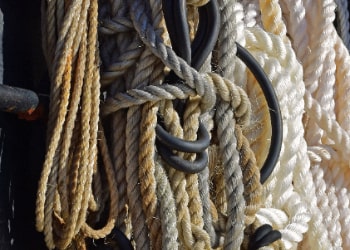Marine Rope: What Works Best?
Finding the Right Rope
Before synthetic rope was made, natural materials were used for rope on historic boats and vessels. Now most marine ropes are made of synthetic fibers like polyester, nylon, and polypropylene for both land and underwater purposes. They are applied to sails, anchors, and securing the boat or items on the boat. It is extremely important to know what materials and construction of rope you are using for each purpose. Some key things to look for when deciding what rope to get is noting how strong and durable the rope is, whether it floats or sinks, and how much it stretches when in use or when it gets wet.
Difference Between Materials

One of the more popular ropes used in marine use are made out of polyester. Even though this type of rope doesn’t float, it is typically cheaper than other marine ropes and it a has great strength as well as resistance to abrasion and UV light. Polyester rope is easy to splice, and due to the fact that the rope sinks, it is mot commonly used for anchor lines. Another common anchor line rope is the nylon rope because of its elasticity and shock absorption. On the other hand, it does weaken when it gets wet which would mean that if a nylon rope is being used as an anchor line that it may have to be replaced more frequently. One other common rope is polypropylene that is used on smaller boats and vessels. Polypro rope floats on water making it a great rope for safety lines in the water.
Kinds of Rope Construction

There are also the options of having a braided or twisted rope. A double braided rope is constructed with a braided core that has a braided cover, which makes the rope easier to handle when rigging or running lines. Single braided ropes have a parallel core with a braided cover making it more flexible, and it won’t kink. These kinds of ropes are best for large dock lines and furling lines. Finally, a twisted rope can be easier to handle, more durable, and has improved flexibility, so it is used in a wide range of purposes like docking, mooring, or being used with an anchor or as a tow line. For more info on the differences between braided and twisted rope, go to "Difference Between Braided and Twisted Rope," in our Guides and Ideas.

